生态学的一个主要挑战是理解不同物种如何相互作用来决定生态系统功能,特别是在具有大量共存物种的群落中。本研究使用基于性状的微生物凋落物分解模型来量化不同类群对生态系统功能的影响。此外,本研究构建了一个新颖的框架,使用DEMENT模拟器在环境、潮湿和干旱的气候情景下进行了微生物排除实验,突出了分类群特征和环境条件之间的相互作用,重点关注它们对群落相互作用和生态系统功能的综合影响。结果表明,一个类群的生态系统影响是由其资源获取特征和群落功能能力驱动的,但生理胁迫放大了正负相互作用的影响。此外,即使微生物与其他类群之间存在负的两两相互作用,也可能对生态系统功能产生净的积极影响。随着群落对全球气候变化响应的转变,本研究结果揭示了从分类群特征和相互作用预测群落生物地球化学功能的潜力。
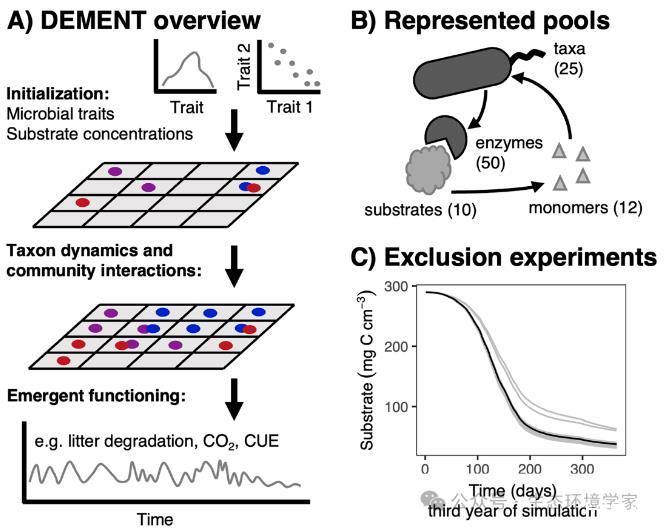
FIGURE 1|Schematic of the DEMENT model and experimental design.(A)DEMENT is spatially explicit and represents microbial traits,taxon dynamics,community interactions and emergent functioning.(B)We modelled 10 substrates,50 enzymes,12 monomers(one for each substrate as well as two pools that represent inorganic nitrogen and phosphorus)and 25 microbial taxa.(C)To quantify taxon impacts on ecosystem function,we conducted exclusion experiments in which we removed a focal taxon from the initialization.The black line indicates a simulation with all taxa present.Grey lines indicate exclusion simulations without the focal taxon.
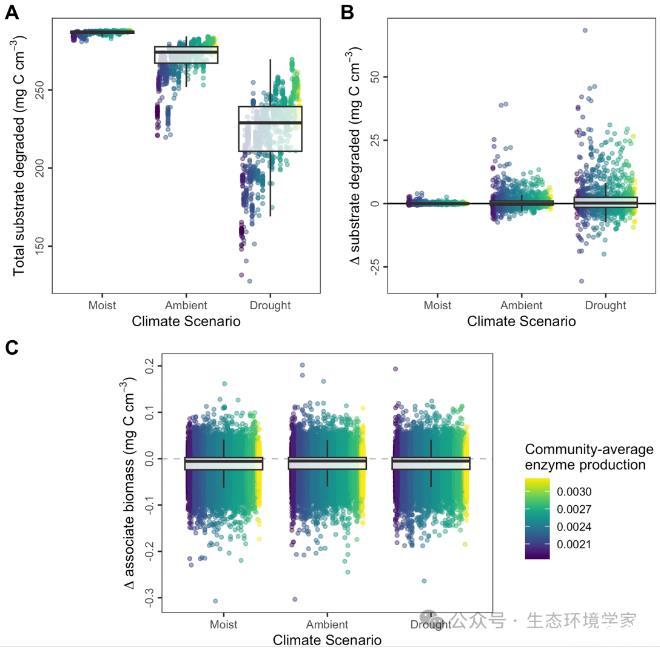
FIGURE 2|(A)Total substrate degradation varied significantly with both climate scenario(F251.88=17,712,p<0.05)and community context(F251.88=221.7,p<0.05).Total substrate degradation decreased with drought and increased with community-average enzyme production.Points are ordered on the x-axis and coloured by community-average enzyme production.(B)Taxon impacts on ecosystem function,defined as the change in substrate degradation when a focal taxon is excluded.(C)Taxon impacts on community dynamics,defined as the pairwise change in average biomass of an associate taxon when a focal taxon is excluded.
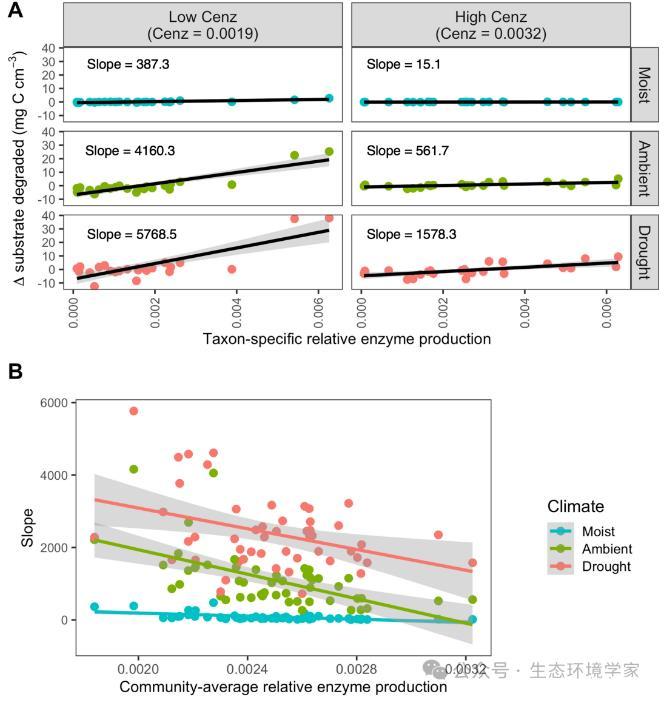
FIGURE 3|(A)The impact of a focal taxon on substrate degradation is positively related to the taxon-specific relative enzyme production,but the relationship is mediated by community-average relative enzyme production(Cenz)and climate.Points are coloured by climate scenarios.Data are shown here for representative communities with low and high Cenz,but analyses were conducted for all 50 replicate communities.The black lines represent the predicted taxon impact from a linear regression that includes taxon-specific relative enzyme production,community-average relative enzyme production,climate conditions and their interaction(p-value<0.001,R2=0.45).(B)The relationship between the impact of a focal taxon on substrate degradation and taxon-specific relative enzyme production(i.e.the slope from Panel A)is negatively related to community-average relative enzyme production and mediated by climate conditions(multiple regression:p-value<0.001,R2=0.70).
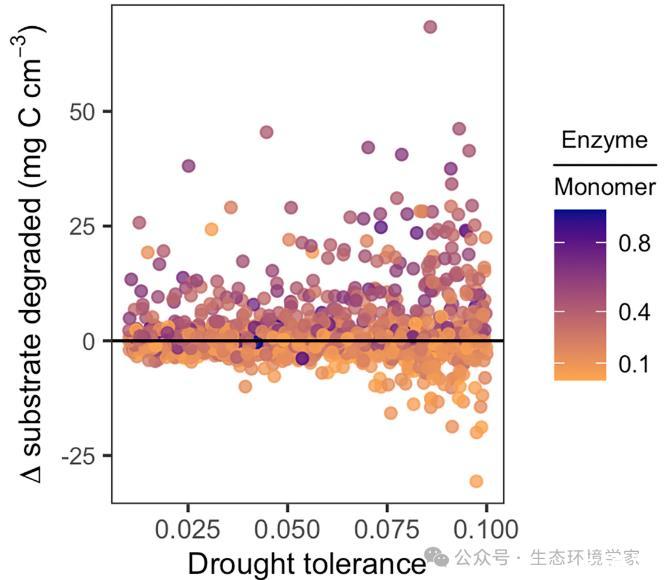
FIGURE 4|Taxon impacts on substrate degradation in relation to drought tolerance.Points are coloured by taxon-specific exo-enzyme production relative to monomer use,with lower values representing cheating strategies.Data are shown from simulations under the drought climate scenario.
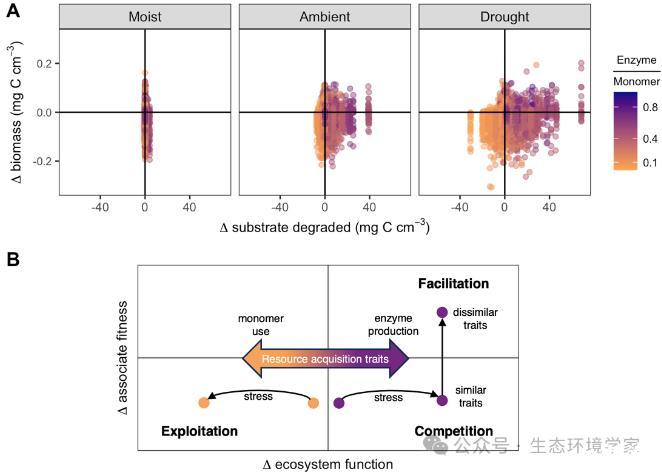
FIGURE 5|(A)Focal taxon impacts on associate biomass and substrate degradation.Points are coloured by taxon-specific exo-enzyme production relative to monomer use,with lower values representing cheating strategies.(B)A generalisable framework for predicting taxon impacts on community dynamics and ecosystem function.Traits associated with resource acquisition determine whether impacts on ecosystem function will be positive or negative,but environmental stress amplifies the impact on ecosystem function in both positive and negative directions.In our simulations,under low environmental stress,focal taxa did not have meaningful impacts on substrate degradation regardless of taxon traits.When environmental stress was high,taxa that invested in greater enzyme production had more positive impacts on resource degradation.Trait dissimilarity between the focal taxon and the associate taxa determines whether exclusion of the focal taxon will lead to positive or negative impacts on the associate's fitness(y-axis position).Analysis of our data showed that,when a focal taxon had high positive impacts on substrate degradation,similar taxa tended to have competitive interactions and dissimilar taxa tended to have facilitative interactions.Furthermore,there were very few focal taxa that had negative impacts on substrate degradation and positive impacts on associate taxa(upper left quadrant)because positive impacts on associates require higher rates of enzyme production by the focal taxon.
相关新闻推荐
1、猫疱疹病毒Ⅰ型毒株HRB2019分离培养、增殖与鉴定方法(二)
